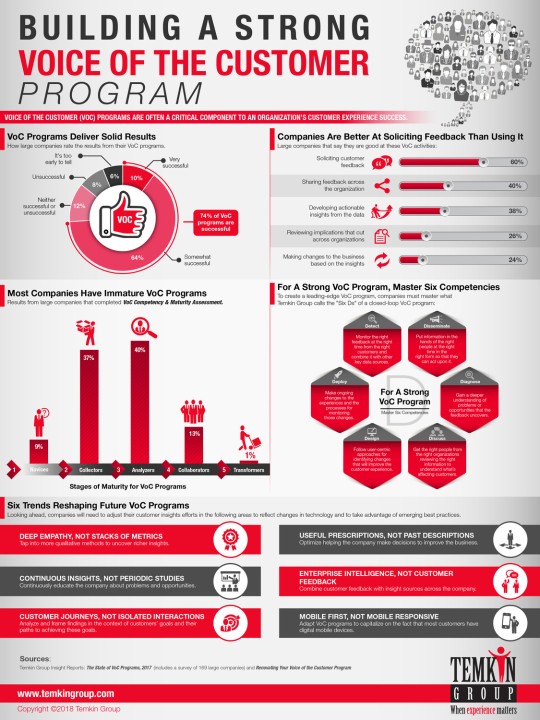When talking to organisations about what we do, the answer we’re getting is: ‘oh we already have surveys’, or ‘we are already doing NPS’. But when asked what the results of those are, the answer is less clear and outspoken. Companies are better at soliciting feedback than using it. When asked about the challenges they face with their programmes, we see the following come back:
1) After doing NPS for X years, we see the engagement of employees drop. They don’t seem to care anymore.
2) We are getting high level insights, but it is very difficult to really get to root causes. We even invested in text mining tools!
3) It’s difficult to read through all of the feedback, so we’re often guessing about the evolutions up or down in our scores.
4) To get to insights, our surveys are really long but nobody is filling them in anymore. Our response rates plumet.
Research by Temkin (now XM Institute) on the adoption of Voice of the Customer tools supports these findings. While most organisations are good at collecting feedback, only 40% is actively spreading feedback and insights across the organisation, 38% draw actionable insights from it and only 24% is making changes in the business!
All four challenges can be categorised under lack of actionability. That’s where AI-powered feedback & insights platforms like Hello Customer come into play. Cutting it short, because your time is valuable, if you want to get to real actionable insights across your customer journey, it takes more than setting up a survey and getting the results.
So I’ll share with you the steps in our methodology to get to actionability. It’s the combination of the right questions at the right time aligned with your business goals, combined with your operational data (customer data, transactional data, context data) that will lead to actionable root cause analysis.
The long version in steps:
1) Align Customer Experience with your business goals. What do you actually want to achieve? Any feedback programme will fail if it is set-up too broad. It's not just about 'we want a higher NPS or we need to increase customer satisfaction'. If there is not a common purpose, engagement will be low. Without a clear compass, the insights you’re getting will just be data. Any programme will not tell you what to do. But a great programme will point you in the right direction and give you the insights to translate into concrete CX projects (which can even be a delivery process optimisation!), which you can further track and finetune with the feedback programme.
2) Define your moments you need to gather insights from continuously. It’s important to understand those moments very well. Because it will define which questions to ask your customers (more on that in step 4)
3) Define the operational data you need to give more depth and context to your insights. Most companies gather all kinds of data, but without purpose it’s not easy to put it to work. We typically focus on 3 data buckets:
a. Customer Data: demographics, personas, …
b. Transactional Data: ticket data for purchases, products, discounts, …
c. Context Data: which agent, salesperson, shop assistant, in which location, which channel, own branch or franchise, … anything that describes the context of the interaction you’re getting feedback from.
Gathering this operational data in a feedback tool is crucial for a deeper level of understanding, but also in order to keep the line of questions for customers low. Great feedback tools will merge this data automatically with the customer feedback and in real-time. So there is no afterwards hassle of trying to bring it together.
4) Define the questions to ask. Of course we always have a metric: NPS, CES or CSAT and an open feedback question. For more rich feedback never ask ‘what can we improve’, but ask ‘why did you give us this score’? Keeping it broad increases your response rate to this question and gives you both positive and negative feedback. But depending on your goal and the richness of your operational data, you may want to ask an additional very pointed question. That can be multiple choice, yes/no, another scale… Just be aware: the more questions you ask, the lower the response will be and the less valuable the insights become. If you are running a continuous programme, you can alternate questions, depending on the projects you are running at the time or trends you are seeing in the open feedback you’d like to further quantify.
5) Make sure to share individual feedback and insights as wide and deep in the company as possible. But make sure you share relevant feedback per department or team. This way everyone from back-office to frontline will become aware of their own impact on customer experience. And start with the GOOD insights and the happy customers. It will create a wave of positivity and enthusiasm you can ride on!
Setting up your programme this way will lead to insights that drive action. Because you are bringing together such richness in data in realtime in a continuous flow, you have a true compass to lead you to the priorities at hand, doing the right things.
Small appendix: setting this up should not take you half a year! With tools like Hello Customer, you are up and running in a matter of weeks.


Subscribe to the Hello Customer newsletter and receive the latest industry insights, interesting resources and other updates.